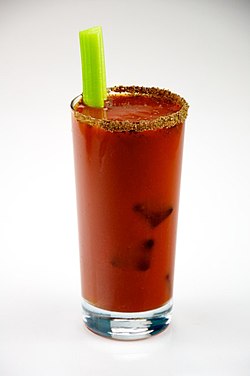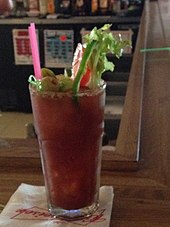
A Manhattan is a cocktail made with whiskey, sweet vermouth, and bitters. While rye is the traditional whiskey of choice, other commonly used whiskies include Canadian whisky, bourbon, blended whiskey, and Tennessee whiskey. The cocktail is usually stirred with ice then strained into a chilled cocktail glass and garnished traditionally with a maraschino cherry. A Manhattan may also be served on the rocks in a lowball glass.
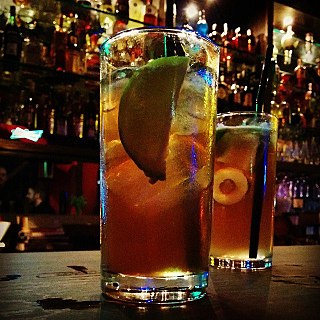
The Long Island iced tea, or Long Island ice tea, is an IBA official cocktail, typically made with vodka, tequila, light rum, triple sec, gin, and a splash of cola. Despite its name, the cocktail does not typically contain iced tea, but is named for having the same amber hue as iced tea.

The martini is a cocktail made with gin and vermouth, and garnished with an olive or a lemon twist. Over the years, the martini has become one of the best-known mixed alcoholic beverages. A popular variation, the vodka martini, uses vodka instead of gin for the cocktail's base spirit.
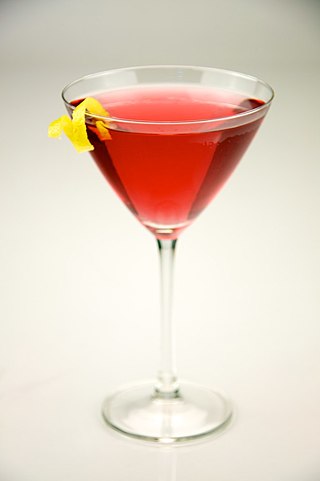
A cosmopolitan, or, informally, a cosmo, is a cocktail made with vodka, Cointreau, cranberry juice, and freshly squeezed or sweetened lime juice.
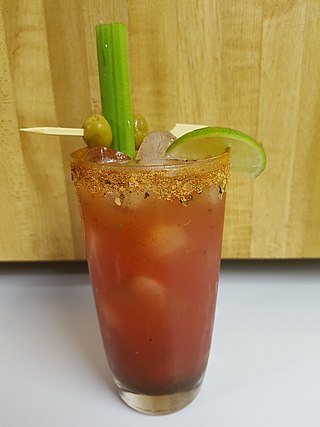
A Caesar is a cocktail created and consumed primarily in Canada. It typically contains vodka, Clamato, hot sauce, and Worcestershire sauce, and is served with ice in a large, celery salt-rimmed glass, typically garnished with a stalk of celery and wedge of lime. What distinguishes it from a Bloody Mary is the inclusion of clam broth. The cocktail may also be contrasted with the Michelada, which has similar flavouring ingredients but uses beer instead of vodka.

Rémoulade is a cold sauce. Although similar to tartar sauce, it is often more yellowish, sometimes flavored with curry, and often contains chopped pickles or piccalilli. It can also contain horseradish, paprika, anchovies, capers and a host of other items.
Sangrita, is a Mexican non-alcoholic drink often served with tequila – customarily a shot of tequila blanco. Its origin dates back to the 1920s.
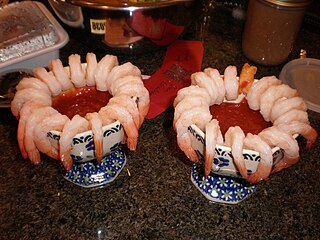
Cocktail sauce, also known as seafood sauce, is one of several types of cold or room temperature sauces often served as part of a dish referred to as a seafood cocktail or as a condiment with other seafoods. The sauce, and the dish for which it is named, are often credited to British celebrity chef Fanny Cradock, but seafood cocktails predate her 1967 recipe by some years.
A glass rimmer is a bar accessory used to apply salt or sugar to the rim of a glass. It usually consists of one or more shallow plastic or metal discs that the glass is turned upside down into. The discs can be filled with either the rimming salt or sugar, or sometimes something to moisten the rim of the glass such as lime juice.
Fernand Petiot was a bartender who claimed to have created the Bloody Mary, a popular cocktail drink.
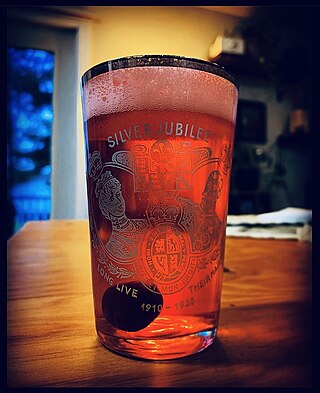
A beer cocktail is a cocktail that is made by mixing beer with other ingredients or another style of beer. In this type of cocktail, the primary ingredient is usually beer.

Cocktail garnishes are decorative ornaments that add character or style to a mixed drink, most notably to cocktails.
Drink mixers are the non-alcoholic ingredients in mixed drinks and cocktails. Mixers dilute the drink, lowering the alcohol by volume in the drink. They change, enhance, or add new flavors to a drink. They may make the drink sweeter, more sour, or more savory. Some mixers change the texture or consistency of the drink, making it thicker or more watery. Drink mixers may also be used strictly for decorative purposes by changing the color or appearance of the drink. They also simply increase the volume of a drink, to make it last longer.

Marie Rose sauce is a British condiment often made from a blend of tomatoes, mayonnaise, Worcestershire sauce, lemon juice and black pepper. A simpler version can be made by merely mixing tomato ketchup with mayonnaise. The sauce was popularised in the 1960s by Fanny Cradock, a British cook.
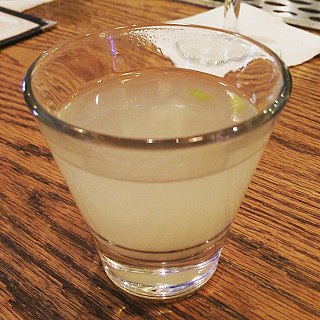
Clam juice is a broth derived from steamed clams, which can be consumed on its own or used as an ingredient in various dishes and beverages.

Bloody Margaret is a variation on the cocktail Bloody Mary, made with gin instead of vodka - known as a Red Snapper in the United States.
